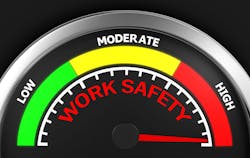We all know how to respond when an accident occurs in our facility. First, we make sure the person involved is cared for and their injuries are treated appropriately. Then, we investigate. Sometimes, the causes and contributing factors are evident, and we can put plans and actions into place to prevent future accidents. Other times, the answers aren’t so clear.
But what if, rather than spending all that time, effort and energy on reacting to an accident, we direct those investments toward preventing accidents?
We can never fully know when accidents and injuries are going to happen. But, by implementing prevention-based programs and value-added activities, we can keep our people and facilities safe. Here are four ways we can move the safety needle, all while improving safety performance and saving money.
1. Measure safety performance through the lens of prevention.
As safety professionals, we’re asked to report on safety metrics related to how often injuries occur during a specified period of time and how much those injury claims cost our companies. For example, a $22,000 claim from a back injury while lifting or a $3,000 claim for a strained wrist from a slip, trip or fall.
Perhaps, instead of reporting injuries, we should measure the preventive activities that help reduce our risk of injuries in the first place. In practice, this means that the next time someone in your facility is injured in an incident, rather than broadcasting the uncontrollable cost of medical treatment, share instead how many times you see cords draped across work areas or how many work areas have room for improvement with housekeeping. This way, the information reported shows your team the importance of prevention as opposed to the costs of occurrence.
2. Recruit people to be on your prevention team.
If you already have a safety committee, mobilize them to focus on prevention activities, which might be tools already in your accident prevention toolbox. Examples include checklists for:
- Slips, trips and fall prevention;
- Proper personal protection equipment usage;
- Safe behaviors; and
- Ladder safety.
Something else to consider is the connotation of safety committees versus prevention teams. Sometimes, safety committees are perceived as safety police. If the majority of what your safety committee does on the manufacturing floor is compliance-based, they’re probably not the most welcoming sights to workers. If your safety committee instead becomes a prevention team, there’s a better chance that workers will view and react to them in a different light. In fact, they may even help with problem solving efforts.
3. Plan to prevent.
Developing critical lift, hot work and confined space plans are required because they keep people safe and increase safety awareness. If you know when and where accidents are happening in your facility, then you know where to focus your efforts, such as adding prevention steps into your procedures.
Supervisors should always review upcoming work and projects. If they identify areas where accidents or near misses previously occurred, then they should make plans to prevent future hazards. This reinforces the idea that safety and accident prevention is possible.
If supervisors say they “don’t have time” to get creative in their prevention plans, remind them how much time injuries cost. For example, highlight some of the following costs:
- Employee time off to be evaluated and treated,
- Production interruptions from fewer workers on the line,
- Hiring and training replacement workers (temporary or full-time) and
- Overtime costs if replacement workers can't be found.
Supervisors lose even more of their time when they have to complete the necessary supervisor reports that accompany incident reporting. Such discussions are almost always eye-openers when backed by data.
4. Train and talk to your target audience.
Safety training is a critical part of all health and safety programs. OSHA clearly and succinctly explains those, by industry, in its Training Requirements in OSHA Standards publication.
For too many workers and supervisors, the value of safety training is only realized after accidents or injuries occur. Developing safety training that is engaging, interesting and in-depth is more than a requirement. It’s a way to further the message and improve safety within your organization. Value-added safety training provides instruction for and reengages employees of all experience levels and responsibilities in the workplace.
Training is necessary and goes beyond compliance with laws and regulations. Preventative training can help to reduce the risk of incidents in the workplace, save lives and, in some cases, avoid accidents altogether.
For more information on what you can do to encourage workers to raise safety and health concerns, visit OSHA’s Safe and Sound Week resources. You can also contact your worker’s compensation insurance provider for further assistance with your specific exposures.
In addition to safety training, accident prevention also provides an opportunity to talk about safety initiatives and get your team aligned on how best to do the job without getting hurt.
Remember that staying proactive is key to moving the safety needle. Start by following these four suggestions and then watch safety awareness and compliance improve.
Brenda Lovitz is a risk and safety manager at Flex Trades, a traveling workforce solutions provider serving companies across all industries of manufacturing.
About the Author
Brenda Lovitz
Brenda Lovitz is a risk and safety manager at Flex Trades, a traveling workforce solutions provider serving companies across all industries of manufacturing.
